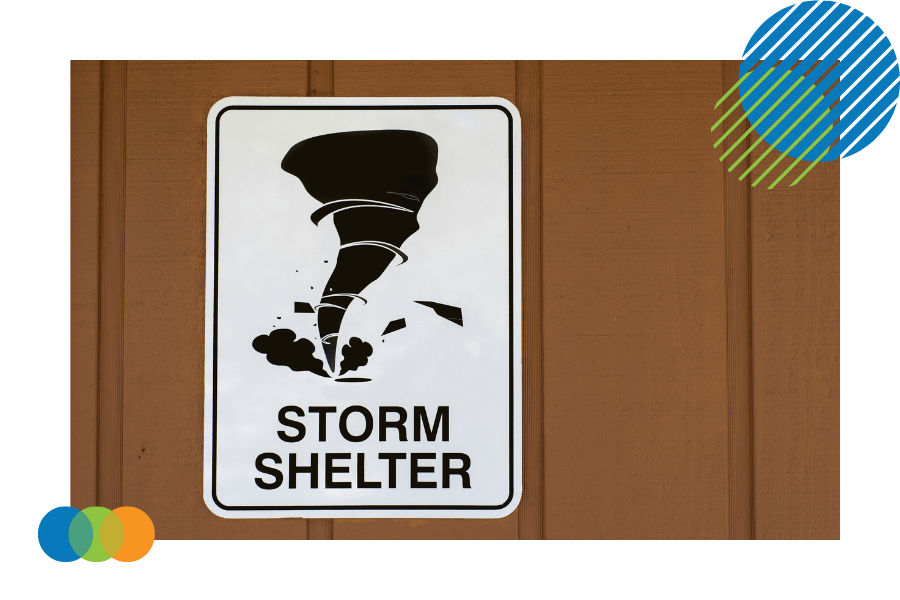 |
Written by Liz McDermott |
Severe weather tornadoes continue to wreak havoc across America, leaving behind property damage worth billions of dollars. These fierce storms now strike in unexpected places, making tornado procedures in the workplace more urgent than ever.
Here's the reality: A tornado destroys everything in its path within seconds. Most businesses lack proper disaster preparedness and evacuation plans during a tornado warning - a gap that puts both workers and customers at risk. The scariest part? These storms often arrive without warning, leaving no room for last-minute plans.
Workplace tornado procedures matter more than checking the emergency response box on a safety form - they save lives. Whether you're building your first emergency plan or running tornado drills, this guide walks you through the essential steps to protect your team when time runs short.
|
This article is made possible by Vubiz’s clients, who utilize our Hurricane and Tornado Preparedness online training course to enhance employees' understanding of OSHA severe weather guidelines, including tornado safety tips. |

Essential Components of a Tornado Emergency Action Plan
Did you know that 75% of businesses without continuity planning fail within three years of a natural disaster? That's why your emergency action plan needs to be rock solid from day one.
What Is a Tornado Emergency?
A tornado emergency is an enhanced version of a tornado warning issued by the National Weather Service (NWS) in the United States. It is reserved for extremely rare situations when all of the following criteria are met:
- A severe threat to human life is imminent or ongoing
- Catastrophic damage is highly likely
- Reliable sources confirm the presence of a large and destructive tornado
This designation conveys the utmost urgency to the public, emphasizing the need for immediate protective action. Tornado emergencies are typically issued when:
- A large, violent tornado has been confirmed on the ground
- The tornado is heading toward a densely populated area
- There is a high likelihood of widespread destruction and numerous fatalities
Conducting Risk Assessment and Facility Evaluation
Tornado prevention starts with the basics: Know your building inside and out. Metal and reinforced concrete are better than wood or brick. Also, look at your location and how often twisters impact the area.
Defining Clear Roles and Responsibilities
A tornado action plan defines who is in charge when things get scary. Your emergency team should include:
- An emergency coordinator (with backup players ready)
- Security folks watching the doors
- Facilities team leaders
- First-aid trained welfare coordinators
- Communications chiefs
Give everyone a job and a workplace tornado drill checklist; no guesswork allowed—train backups for every role. People take vacations, catch colds, or sometimes can't make it in.
Setting Up Multi-Channel Communication Systems
When storms come knocking, you need news fast. Don't put all your eggs in one communication basket—set up backup systems for your backup systems. Your setup should work well with IPAWS (the Integrated Public Alert and Warning System) to catch every possible warning.
Test those warning systems like you mean it. Remember that your team might speak different languages or need special assistance—plan for that. Set up a command center—an Emergency Operations Center (EOC)—where all the critical information lands and decisions take flight.
Step-by-Step Guide to Conducting Effective Tornado Drill Procedures
Think of tornado drills like dress rehearsals for a play - they must be perfect before opening night. OSHA says businesses with 11 or more employees must keep written emergency action plans. Let's make those plans count.
Pre-Drill Planning and Documentation
Pick your drill coordinator to run the show and keep everyone in sync. Map out who does what, from the folks checking empty rooms to the team watching over multi-floor evacuations. You'll want a solid system to track where everyone ends up.
Running Different Drill Scenarios
Emergency drills should feel real because one day, it might be. Start with a tornado watch, turn up the heat with a warning, then get everyone moving to storm shelters. Here's what needs to happen:
- Send those mock weather alerts through your usual channels
- Play out "what-if" scenarios about building damage
- Count heads at your shelter spots
- Test your backup communication plans - because Plan A isn't always enough
Evaluating Drill Performance and Gathering Feedback
The real work starts after the drill ends. Clock the time between your first warning and the last person reaching the underground shelter. Keep your eyes on:
- How well your messages spread
- Whether people moved quickly and safely
- If your headcount matched the reality
- How thoroughly did your teams sweep the building
Don't let those fresh insights slip away - grab feedback within a week. Try surveys, comment cards, or good old-fashioned conversations. These nuggets of wisdom help patch the holes in your safety net.
Implementing Critical Tornado Safety Procedures
OSHA is knowledgeable about tornado safety. It recommends underground areas, primarily basements or storm cellars, as the best protection against wicked winds.
Designating and Equipping Shelter Areas
Look for the sweet spots like small interior rooms on your lowest floor. Brick or concrete walls beat windows any day. Your shelter needs to fit everyone without playing sardines. Stock these safety nooks with the essentials as part of your emergency preparedness plan:
- First aid kits and water (because Band-Aids and hydration matter)
- Battery-powered NOAA weather radio
- Flashlights with spare batteries
- Two-way emergency communication devices
- Emergency blankets, emergency supplies, and tools
Creating Evacuation Routes and Assembly Points
Your evacuation routes to shelter locations need enough elbow room for everyone to move quickly; no obstacle course. Place those evacuation maps everywhere that matters. Mark your safe rooms, emergency protective gear, and meeting points like you're designing the world's most crucial treasure map.
Establishing Headcount Protocols
Nobody gets left behind. That's the rule. Assign one warden for every 20 employees to shepherd folks to safety. Keep those department rosters fresh and make visitors sign in—no mystery guests during emergencies.
Your headcount checklist demands:
- Quick counts when everyone's in the shelter
- Notes on where missing folks were last spotted
- Updates flowing to your emergency chiefs
- Crystal-clear reporting rules
Keep those emergency contacts current and your backup plans backed up. Because when tornadoes come calling, knowing where everyone is matters more than anything else.
Employee Training for Tornado Emergencies
OSHA tornado shelter requirements speak plainly about employee safety: protect your workers from severe weather hazards. Good tornado safety training might save someone's life.
Required Workplace Safety Training Components
Your team needs both book smarts and street smarts here. Teach them the 30/30 rule for outdoor safety and show them how to protect themselves. You know, that duck-and-cover tornado safe position under something sturdy. Here's a wake-up call: tornado warning systems give you about 13 minutes to act. That's it.
Hands-on Practice Sessions
Forget PowerPoint presentations. Sure, classroom time helps, but real practice sticks. Your team should master:
- Smart sheltering (hint: room corners aren't your friend)
- Equipment shutdown tricks
- Handling flammable or hazardous materials
- Every possible way to send messages
- Spotting dangers after the storm passes
Testing Knowledge Retention
Even old pros need practice. Test everyone yearly on your tornado evacuation plan, then repeat when tornado season kicks off in March or April.
Verify every safety protocol gets followed correctly. Keep those training records fresh and current, especially when Bob from accounting moves to sales.
One more thing: storms shake people up differently. Some folks show it right away, others bottle it up [16]. Weave some stress management tricks into your training. Because keeping your team's heads clear matters as much as keeping them safe.
Conclusion
Tornado safety is no longer optional. These storms are more destructive and appear in more unexpected places. Your emergency action plan and accountability procedures aren't just paperwork; they're your playbook for keeping people alive.
We know what works: solid risk assessment, clear messages everyone understands, and shelter areas ready for action. Practice makes the difference between chaos and calm when those 13 minutes of warning start ticking down.
Risk management that protects your team requires more than good intentions—it requires solid preparation. Want to boost tornado awareness in your workplace? Take a look at Vubiz's Hurricane and Tornado Preparedness training course. Remember that the best safety plans work because people practice, understand, and act on them without hesitation.
Tornado business preparation today writes tomorrow's survival stories. Keep your plans fresh, your shelter areas stocked, and your team sharp. When storms call, readiness isn't everything—it's the only thing.
